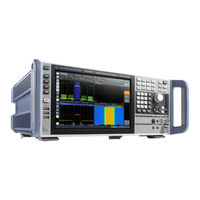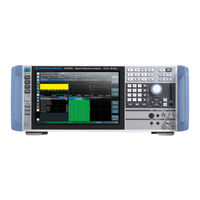R&S FSV3004 Signal Analyzer Manuals
Manuals and User Guides for R&S FSV3004 Signal Analyzer. We have 3 R&S FSV3004 Signal Analyzer manuals available for free PDF download: User Manual, Security Procedures
R&S FSV3004 User Manual (1268 pages)
Signal and Spectrum Analyzer
Brand: R&S
|
Category: Measuring Instruments
|
Size: 24.7 MB
Table of Contents
-
-
1 Preface
15
-
-
-
-
-
-
Amplifier110
-
Fdd Bts110
-
Fdd Ue110
-
Spectrum110
-
Gsm111
-
I/Q Analyzer111
-
Lte111
-
NB-Iot111
-
R&S Multiview112
-
-
Phase Noise112
-
Wlan112
-
-
-
OBW Results201
-
SEM Results207
-
SEM Basics210
-
Sweep List
221-
Reference Range228
-
Power Classes230
-
MSR Settings231
-
Standard Files234
-
-
Detector257
-
Filter Type257
-
Rbw257
-
Sweep Time257
-
Sweep Time Mode257
-
Vbw257
-
Preamp258
-
Reference Level258
-
RF Attenuation258
-
Stop after Sweep258
-
Sweep Points258
-
Transducer258
-
Delete Range259
-
Limit Check259
-
-
-
Margin260
-
Show Peaks260
-
Details261
-
Peaks Per Range261
-
Examples276
-
-
TOI Basics292
-
TOI Results296
-
-
Input Coupling312
-
Direct Path313
-
Impedance313
-
YIG-Preselector313
-
-
Power Sensors316
-
Output Settings351
-
If/Video Output352
-
Audio Output353
-
-
Triggering392
-
Gating402
-
-
-
Zoomed Displays419
-
-
Zoom Functions421
-
-
Marker Usage426
-
-
Marker Settings429
-
Display Lines468
-
Limit Lines470
-
Standard Traces486
-
Spectrograms498
-
Trace Math516
-
-
-
Alignment561
-
Display Settings567
-
Managing Rules581
-
Defining Rules582
-
Configuration590
-
Transducers592
-
System Messages619
-
Firmware Updates620
-
-
-
Messages654
-
VISA Libraries654
-
GPIB Languages683
-
The IECWIN Tool685
-
Remote Settings699
-
LXI Settings705
-
Remote Errors707
-
-
Common Commands731
-
Common Suffixes731
-
List Evaluations866
-
Deprecated Commands1195
-
Programming Examples1198
-
Service Request1202
-
15 Maintenance
1211-
Cleaning1211
-
-
16 Troubleshooting
1213
-
Advertisement
R&S FSV3004 User Manual (307 pages)
I/Q Analyzer and I/Q Input Interfaces
Brand: R&S
|
Category: Measuring Instruments
|
Size: 5.98 MB
Table of Contents
-
-
-
-
Hysteresis75
-
-
6 Analysis
89 -
Section 8
98 -
Section 9
102-
Marker State102
-
Marker Type102
-
Selected Marker102
-
Reference Marker103
-
Select Marker103
-
All Marker off104
-
-
I/Q Analysis216
-
-
-
Index300
R&S FSV3004 Security Procedures (13 pages)
Signal and Spectrum Analyzer Instrument Security Procedures
Brand: R&S
|
Category: Measuring Instruments
|
Size: 0.84 MB
Table of Contents
-
Overview3
Advertisement
Advertisement


